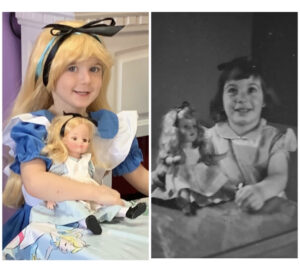“The first step along the journey of change is to know the stage you are in.” – Changing For Good by James O. Prochasksa, Ph.D., John C. Norcross, Ph.D., and Carol C. Diclemente, Ph.D
On that blustery March day, I unpacked the first of two boxes that Amazon delivered — the one with the costume I planned to wear to my granddaughter’s Alice-in-Wonderland 4th birthday party. I was going to be the Queen of Hearts. And ordered an extra-large costume and hoped it would fit. It barely did.
Then I opened the second box with the digital scale. I placed it on the bathroom floor, determined not to react when I saw the number. A little self-talk went a long way….”You’re a big girl,” I told myself. “This is not your first rodeo.” I decided I would only weigh myself on Wednesdays. Weigh-Day, I called it. Once a week was enough.
I did not have a specific plan or diet, so I began by incorporating some strategies from the past to get me started. I still had my old Weight Watchers scale that needed new batteries. I remembered the portion sizes used for visual measurement: your palm (four ounces of protein), fist (cup), and the size of the first digit of my thumb (tablespoon). I had tried another program that had me drink an ounce of water per every two pounds of weight. I had fasted, eating between 12 noon and six p.m.
Why hadn’t I fully succeeded with those methods? I didn’t know the answer to that question yet, but I had plenty of diet cookbooks on my kitchen shelves with healthy recipes to get started. I was ready to take action. The how would evolve over several months of experimentation, discovery, and accountability. The why was more important: I wanted to live a long and healthy life and see my grandchildren grow up.
“At all times and under all circumstances, we have the power to transform the quality of our lives.”
– Werner Erhard
We deal with change at various junctures in our lives. Some change is thrust upon us unexpectedly, such as a diagnosis of cancer or asymptomatic high blood pressure. Sometimes we choose to change ourselves knowing it would be healthier to stop smoking or quit drinking diet soda.
Lasting change doesn’t occur overnight. Instead, many behavior experts theorize that it occurs through a multistage process, Where do you see yourself? What stage do you recognize?
Precontemplation
During this stage, we aren’t ready to make or actively consider making a change. We may not understand that our food choices are unhealthy and/or may claim our choices are not a problem. As a result, we are not intending to take any action
Contemplation
We are getting ready to change by becoming aware of the benefits. We intend to take action in the next six months, but the cons of changing may still seem greater than the pros; this feeling of uncertainty often creates a sense of ambivalence.
Preparation
During this stage, we are ready for change. We are determined or intend to take action in the next 30 days and begin making shifts to prepare for it, such as exploring options and planning action steps.
Action
We begin implementing behavior change. We are successfully taking action, but change is still new. There are often challenges, adjustments, and lessons as we learn how to make our desired changes work for us.
Maintenance
During this stage, we have sustained new healthy changes for more than six months. We have ceased prior unhealthy behaviors and are forming new, healthy patterns as our recent changes become habitual.
Termination
When we have successfully integrated the new change into their daily lifestyle, we are confident with the changes we have made and do not feel tempted to return to old patterns.
Recycling
This is when we might return to a previous stage in the cycle. It can occur at any point on the path to change and is a normal part of the change process. The journey is not always a straight line.
I see myself as a self-changer. I think you are one, too.
♥ Susan L. Ward
Integrative Nutrition Health Coach


